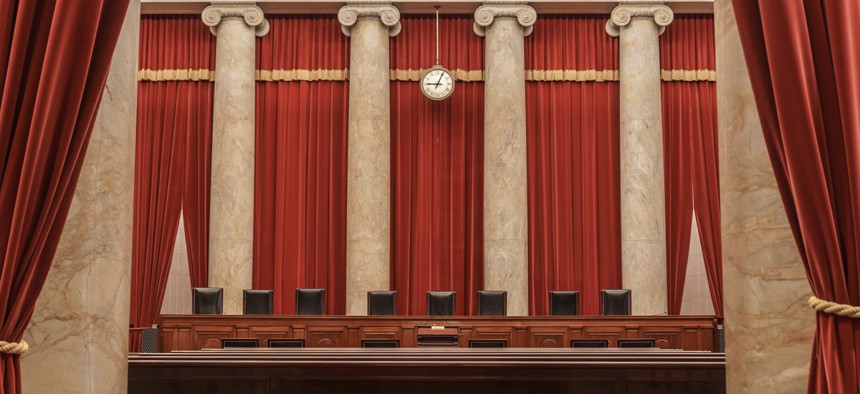U.S. Supreme Court Finds That California Crisis Pregnancy Law Violates Free Speech

Inside the Supreme Court Shutterstock
The decision likely will have broader implications as other jurisdictions have disclosure requirements on the books for pregnancy centers, although those have also been subject to legal challenges.
The U.S. Supreme Court ruled Tuesday that California can’t require crisis pregnancy centers to post information to inform pregnant women about the availability of free or reduced-cost abortions.
The 5-4 opinion, written by Justice Clarence Thomas, found that the 2015 law likely violates the First Amendment free speech rights of the people running the clinics, which are set up as alternatives to abortion clinics to encourage women to carry their pregnancies to term. They also often provide medical care and offer information on adoption.
“Here, for example, licensed clinics must provide a government-drafted script about the availability of state sponsored services, as well as contact information for how to obtain them,” Thomas wrote. “One of those services is abortion—the very practice that petitioners are devoted to opposing. By requiring petitioners to inform women how they can obtain state-subsidized abortions—at the same time petitioners try to dissuade women from choosing that option—the licensed notice plainly ‘alters the content’ of petitioners’ speech.
The law required licensed centers to notify women about California's reproductive health services, including abortions, as well as provide a phone number. Some of the clinics are unlicensed facilities and Thomas’ opinion also rejected a California requirement that those centers acknowledge in advertisements and at their facilities that they aren’t licensed to perform medical care.
The decision could have broader implications than just the California law, as at least 10 cities or counties have written ordinances that require disclosures or restrict advertising at pregnancy centers, according to a brief filed earlier this year by a group of local governments that included San Francisco, New York City and Baltimore. Some of those local laws already have been struck down by lower courts.
Similar laws in Hawaii and Illinois could also be affected by the ruling, the Associated Press noted.
The case split along a frequent ideological divide at the court, with Justices Samuel Alito, John Roberts Jr., Anthony Kennedy and Neil Gorsuch joining in the majority opinion.
Justice Stephen Breyer, who wrote the dissent, criticized the majority as breaking with a 1992 decision about a Pennsylvania law, in which the court found that the state could require doctors to inform women about the health risks associated with abortion and childbirth, as well as other information. He noted that because of that case, states can require doctors to tell women who want abortions about adoption, questioning how the requirements on the pregnancy centers were any different.
He was joined by the other, more liberal, members of the high court: Justices Sonia Sotomayor, Ruth Bader Ginsburg and Elena Kagan.
Breyer also more broadly questioned whether Thomas’ decision could have an end result of invalidating a wide array of rules laid down by governments in many different areas.
“Because much, perhaps most, human behavior takes place through speech and because much, perhaps most, law regulates that speech in terms of its content, the majority’s approach at the least threatens considerable litigation over the constitutional validity of much, perhaps most, government regulation,” he wrote.
Lisa Soronen, the executive director of the State and Local Legal Center, told Route Fifty this is the aspect of the Thomas decision—and Breyer’s dissent—that she was most focused on.
“State and local governments require tons and tons of notices,” said Soronen, who filed a brief before the court that looked at this issue. While most of those are not as controversial—like mandating posters at restaurants telling employees to wash their hands or provide information about how to help someone choking—the Thomas opinion leaves open the possibility that someone could sue to test their constitutionality, she said.
"We don't know exactly what lines have been drawn," Soronen said, while noting that most innocuous notices would likely survive a legal challenge.
In his decision, Thomas disputed Breyer’s concerns about scores of regulations becoming a target of dispute, writing “we do not question the legality of health and safety warnings long considered permissible, or purely factual and uncontroversial disclosures about commercial products.”
States were split about the case before the ruling. Led by Texas Attorney General Ken Paxton, 22 states filed a brief arguing that laws requiring “informed consent” about abortion, such as the 1992 Pennsylvania law, are different than the kind of disclosures the pregnancy centers were being required to make in California.
But 15 other states and the District of Columbia filed a brief saying the California law fit within the framework of disclosures that states frequently require of medical providers.
For their part, the cities that filed a brief asserted that pregnancy centers often use “intentionally misleading advertising” and other deceptive practices that they needed to regulate.
California Attorney General Xavier Becerra, who defended the law, lamented the decision. “When it comes to making their health decisions, all California women—regardless of their economic background or ZIP code—deserve access to critical and non-biased information to make their own informed decisions,” he said in a statement.
But Thomas Glessner, the founder of the National Institute of Family and Life Advocates, a group representing pregnancy centers that challenged the California law, said the ruling was greeted with relief by the more than 150 centers operating in that state.
“The right of free speech protected in the First Amendment not only includes the right to speak, but also the right to not be compelled by government to speak a message with which one disagrees and which violates one’s conscience,” he said in a news release.
Laura Maggi is the Managing Editor of Government Executive's Route Fifty and is based in Washington, D.C.
NEXT STORY: Opportunity Zone Communities May Require Additional Investments






